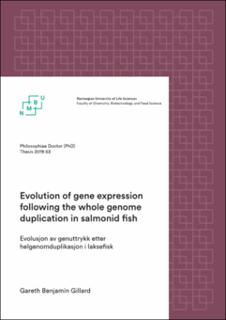| dc.contributor.advisor | Sandve, Simen Rød | |
| dc.contributor.advisor | Hvidsten, Torgeir Rhoden | |
| dc.contributor.author | Gillard, Gareth Benjamin | |
| dc.date.accessioned | 2020-10-06T12:56:14Z | |
| dc.date.available | 2020-10-06T12:56:14Z | |
| dc.date.issued | 2019 | |
| dc.identifier.isbn | 978-82-575-1612-3 | |
| dc.identifier.issn | 1894-6402 | |
| dc.identifier.uri | https://hdl.handle.net/11250/2681382 | |
| dc.description.abstract | Whole genome duplication (WGD) is a rare mutational event that provides additional duplicates of all genes in the entire genome, resulting in functional redundancy. This redundancy leads to relaxation of selective constraints and can in turn spark evolution of novel phenotypes. Although there seem to be an association between WGD and the propensity to survive and adapt to novel environments, this potential link between WGD events and a surge of adaptive evolution is rather anecdotal and not well supported by empirical evidence at this point. In this thesis, we apply various comparative transcriptomics approaches to investigate the impact of a salmonid-specific WGD (4R) on gene expression evolution. In paper I, we investigate the consequences of the WGD on gene regulation in Atlantic salmon lipid metabolism-related pathways. We found pathway specific differences in duplicate retention which was independent of how conserved regulation was between duplicates. We identified gene dosage effects in only certain pathways related to the biosynthesis of unsaturated fatty acids. In paper II, we investigated and compared the consequences of the WGD on the regulation of genes in European grayling and Atlantic salmon. We classify 4R duplicate pairs into different evolutionary scenarios and found that, only a very small fraction (~5%) displayed hallmarks of adaptive evolution of novel tissue regulation. In paper III, we use a phylogenetic statistical framework (based on the Ornstein-Uhlenbeck process) to detect evolutionary shifts in liver gene expression levels in the salmonid lineage compared to outgroup species without the 4R WGD. We observe higher gene expression evolution rates following WGD, with some examples of likely adaptive increases in liver gene expression. However, the majority of expression level shifts conserved across salmonid species represented a decrease in expression compared to the pre-4R ancestral expression levels. This suggests that strong selection for dosage compensation is acting on early evolution of gene expression following WGD. Taken together, this thesis describes how gene expression diverged after the WGD in salmonids and represents a first step towards a genome wide understanding of the consequences of WGD on evolution of gene expression. | en_US |
| dc.language.iso | eng | en_US |
| dc.publisher | Norwegian University of Life Sciences, Ås | en_US |
| dc.relation.ispartofseries | PhD Thesis;2019:53 | |
| dc.rights | Attribution-NonCommercial-NoDerivatives 4.0 Internasjonal | * |
| dc.rights.uri | http://creativecommons.org/licenses/by-nc-nd/4.0/deed.no | * |
| dc.subject | Evolution | en_US |
| dc.subject | Gene expression | en_US |
| dc.subject | Whole genome duplication | en_US |
| dc.subject | Salmonid fish | en_US |
| dc.subject | Comparative transcriptomics | en_US |
| dc.subject | Bioinformatics | en_US |
| dc.subject | Gene regulation | en_US |
| dc.subject | Genomics | en_US |
| dc.subject | Transcriptomics | en_US |
| dc.subject | RNA sequencing | en_US |
| dc.title | Evolution of gene expression following the whole genome duplication in salmonid fish | en_US |
| dc.title.alternative | Evolusjon av genuttrykk etter helgenomduplikasjon i laksefisk | en_US |
| dc.type | Doctoral thesis | en_US |

